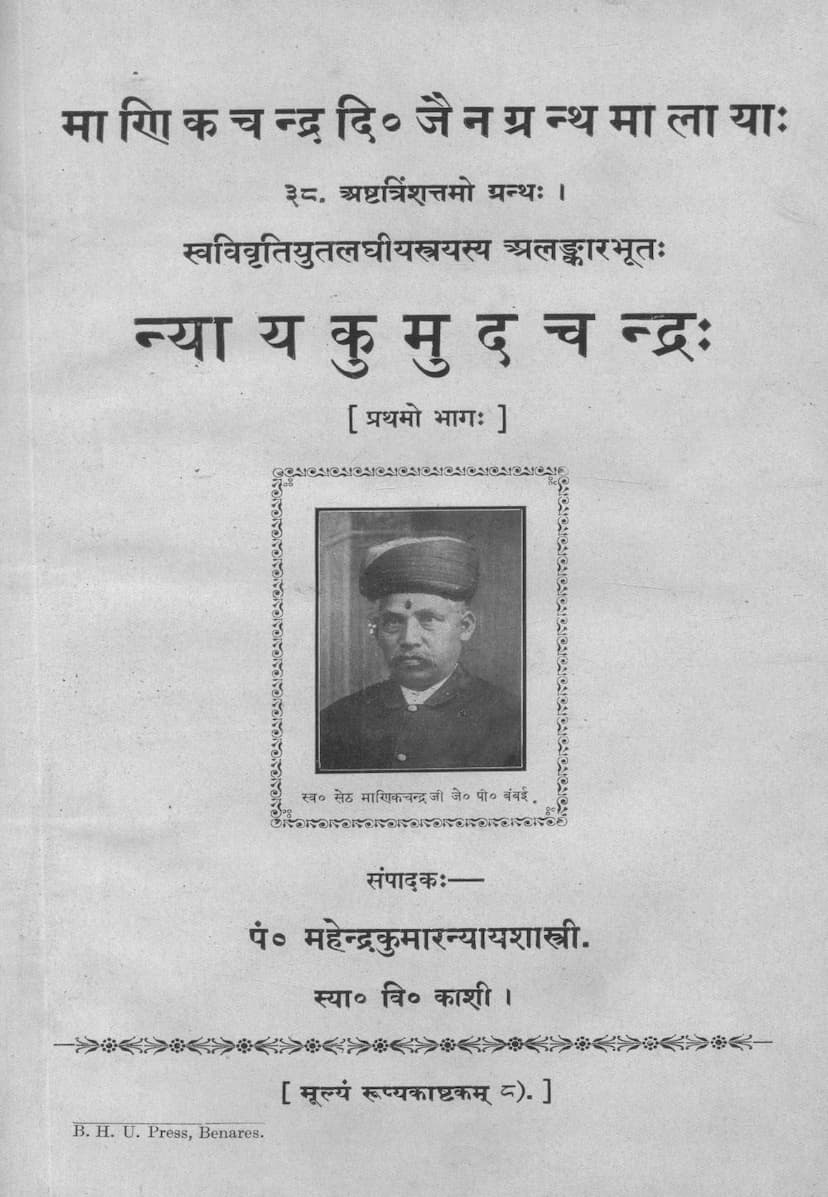Nyayakumudchandra Part 1
Added to library: September 2, 2025

Summary
This is a comprehensive summary of "Nyayakumudchandra Part 1," authored by Mahendramuni and published by Manikchand Digambar Jain Granthamala Samiti.
Book Title: Nyayakumudchandra Part 1 Author: Mahendramuni Publisher: Manikchand Digambar Jain Granthamala Samiti Catalog Link: https://jainqq.org/explore/004326/1
Overview:
"Nyayakumudchandra Part 1" is a foundational Jain philosophical text, presented as a detailed commentary on Bhattakalankadeva's "Laghiyastrya." The work is a significant contribution to Jain logic and epistemology, exploring the intricacies of valid knowledge (pramana) and related philosophical concepts. The edition under review has been meticulously edited and annotated by Pt. Mahendrakumar Nyaya Shastri, a respected scholar of Jain philosophy.
Key Aspects of the Text and its Edition:
- Commentary on Laghiyastrya: The primary purpose of Nyayakumudchandra is to expound upon and clarify Bhattakalankadeva's "Laghiyastrya." This foundational text by Bhattakalankadeva deals with core tenets of Jain logic, particularly concerning valid means of knowledge (pramana) and philosophical categories. Nyayakumudchandra aims to provide a deep and accessible explanation of this complex work.
- Author and Editor: The original author of Nyayakumudchandra is Prabha Chandracharya, a prominent Jain scholar. However, the text is presented in this edition as being "by Bhattakalankadeva" with the commentary by Prabha Chandracharya. The editor of this specific edition, Pt. Mahendrakumar Nyaya Shastri, is highly regarded for his expertise in Jain and ancient Indian logic. His contribution includes providing variant readings, comparative annotations, references to source texts, and other scholarly apparatus to enhance the reader's understanding.
- Publisher and Series: The book is published by the Manikchand Digambar Jain Granthamala Samiti, which is dedicated to reviving and making accessible important Jain literature, particularly ancient works in Prakrit and Sanskrit. This volume is designated as the 38th publication in their series.
- Content and Structure (Based on Subject Index): The Table of Contents (विषयसूली) on page 7 reveals a comprehensive structure:
- Introduction (प्रस्तावना): This section (pages 1-126) provides a detailed introduction to the text, including:
- Introduction to the Works (ग्रन्थ परिचय): An explanation of "Laghiyastrya" and its commentary, Nyayakumudchandra.
- Critical Review of the Works (ग्रन्थों पर समालोचनात्मक विचार): An analysis of the "Laghiyastrya" and its commentary, discussing their style, content, and significance.
- Comparison with Other Philosophies (इतर दर्शनों से तुलना): A significant portion of the introduction is dedicated to comparing Jain philosophies with Vedic, Buddhist, and other Indian philosophical schools. This highlights the unique contributions of Jain logic.
- Introduction to the Jain Acharyas (जैनाचार्य विषय परिचय): Detailed biographical and philosophical introductions to key Jain scholars, with a particular focus on Bhattakalankadeva (pages 24-114) and Prabha Chandracharya (pages 114-117), discussing their lives, works, and influence. It also contextualizes them within the broader landscape of Indian philosophy by comparing them with contemporary thinkers from other traditions.
- Philosophical Doctrines of Laghiyastrya (लघीयस्त्रय के दार्शनिक मन्तव्य): An explanation of the philosophical ideas presented in the original text.
- The Main Text (मूलग्रन्थ): The core text of "Nyayakumudchandra" itself is presented (pages 1-402).
- Variant Readings and Annotations (पाठान्तर-तुलनात्मकटिप्पणी-अवतरणनिर्देशादिभिः): The edition is rich with scholarly annotations, including variant readings from different manuscripts, references to quoted texts and authors, and comparative notes. This makes it a valuable resource for in-depth study.
- Appendices (परिशिष्ट): The edition includes various appendices at the end of the second volume (though only the first volume's content is detailed here), which would likely contain indexes, glossaries, and lists of texts used, proving immensely useful for researchers.
- Introduction (प्रस्तावना): This section (pages 1-126) provides a detailed introduction to the text, including:
- Editorial Approach: The editor, Pt. Mahendra Kumar, emphasizes the critical nature of his work. He utilized ancient manuscripts and adopted modern editorial practices to ensure accuracy and clarity. The annotations are designed to provide not just textual explanations but also historical and philosophical context, tracing the development of ideas across different traditions.
- Significance: The publication of Nyayakumudchandra is seen as a landmark event in Jain scholarship, opening a new era in the critical publication of Jain literature. It aims to elevate the standard of Jain text publication and encourage a broader, more comparative approach to studying Jain philosophy. The editor expresses gratitude to scholars like Pt. Sukhlalji, who encouraged this approach and provided valuable insights.
- Financial Considerations: The publisher, Shri Nathuram Premi, candidly discusses the financial challenges of publishing such scholarly works. He notes the increased costs due to exhaustive annotations and the limited print runs, which are necessary for critical editions. He assures readers that the series' goal is the preservation and dissemination of ancient literature, not profit.
In essence, "Nyayakumudchandra Part 1" is a scholarly reconstruction and detailed exposition of a significant Jain logical text, offering profound insights into Jain epistemology, metaphysics, and its engagement with the broader Indian philosophical discourse. The meticulous editorial work by Pt. Mahendra Kumar makes this edition invaluable for serious students and scholars of Indian philosophy.